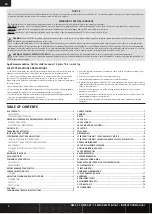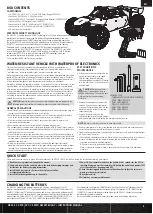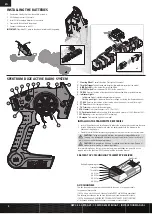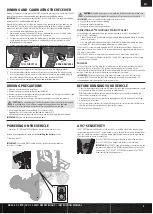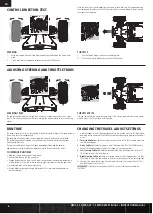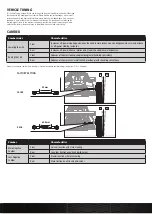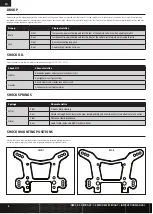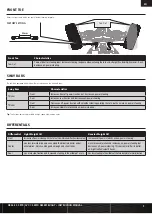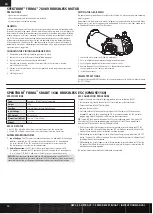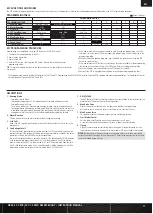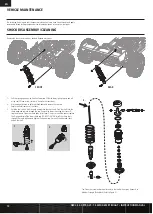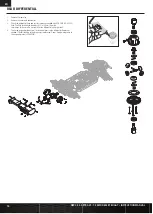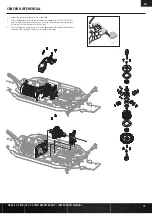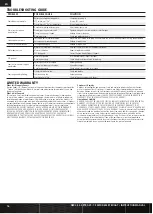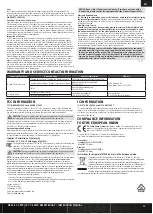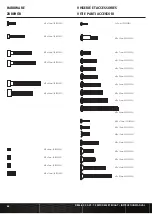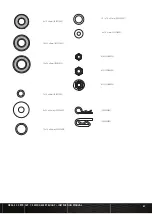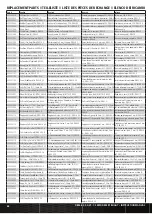
5
EN
DBXL-E 2.0 RTR, AVC: 1:5 4WD DESERT BUGGY • INSTRUCTION MANUAL
2.
1.
DRIVING PRECAUTIONS
• Maintain sight of the vehicle at all times.
• Routinely inspect the vehicle for loose wheel hardware.
• Routinely inspect the steering assembly for any loose hardware. Driving the vehicle off-road
can cause fasteners to loosen over time.
• Do not drive the vehicle in tall grass. Doing so can damage the vehicle or electronics.
CAUTION:
Do not discharge a Li-Po battery below 3V per cell. Batteries discharged
to a voltage lower than the lowest approved voltage may become damaged,
resulting in loss of performance and potential fi re when batteries are charged.
• Do not apply forward or reverse throttle if the vehicle is stuck.
Applying throttle in this instance can damage the motor or ESC.
• After driving the vehicle, allow the electronics to cool before driving the vehicle again.
IMPORTANT:
Keep wires away from all moving parts.
POWERING ON THE VEHICLE
1. Center the ST TRIM and TH TRIM dials on the transmitter and turn it on.
Install a fully charged battery pack per the
Installing the Battery
section.
2. Power on the ESC.
IMPORTANT:
The vehicle MUST remain on a fl at, level surface and motionless
for at least 5 seconds.
AVC
®
SENSITIVITY
The ST RATE dial on the DX2e adjusts the sensitivity, or stability, value in the receiver. If you
increase the sensitivity, the AVC
®
system becomes more sensitive to the vehicle drifting left or
right. You would use maximum sensitivity during high speed driving or drag racing, when you
want the vehicle to stay in a straight line.
Turn the ST RATE knob counter-clockwise to reduce the sensitivity.
Turn the ST RATE knob clockwise to increase the sensitivity.
IMPORTANT:
The ST RATE knob will only adjust the sensitivity when
the transmitter is bound to a DSMR
®
receiver. When the transmitter
is bound to a DSM
®
, DSM2
®
or DSM Marine receiver, the ST RATE
knob controls the steering dual rate.
BEFORE RUNNING YOUR VEHICLE
1. Check for free suspension movement. All suspension arms and steering components should
move freely. Any binds will cause the vehicle to handle poorly.
TIP:
To increase the ride height and ground clearance of your vehicle, screw down the
shock collars to compress the springs.
2. Charge a battery pack. Always charge the battery pack as per the battery and/or charger
manufacturers’ instructions.
3. Set the transmitter steering trim. Follow the instructions to set the steering trim/subtrim so
that the vehicle drives straight with no input to the steering.
4. Perform a Control Direction Test.
FULL THROTTLE
BRAKE/REVERSE
BINDING AND CALIBRATING THE RECEIVER
Binding is the process of linking the SR6100AT receiver to your Spektrum transmitter. The AVC
features on the receiver can be enabled or disabled during the binding process.
IMPORTANT:
You must calibrate the SR6100AT receiver each time it is placed in bind mode,
regardless of AVC being enabled or disabled.
Upon initial setup after the fi rst bind, the model must be confi gured for servo direction, trim
and travel. Then the receiver must be rebound and calibrated to those settings for proper
operation. Center the steering trim and throttle trim on the transmitter before beginning.
1. Press and hold the bind button on the receiver.
2. Power on the receiver. The orange LED fl ashes, indicating the receiver is in bind mode.
Release the bind button after the orange LED illuminates.
3. Put your transmitter in bind mode. The bind process is complete when the orange LED
on the receiver remains lit. The receiver is now bound to the transmitter but must be
calibrated before it will operate.
4. Pull the transmitter trigger to full throttle, pause, then return the trigger to center.
5. Push the transmitter trigger to full brake, pause, then return the trigger to center.
6. Turn the transmitter steering wheel to full right, pause, then return the wheel to center.
7. Turn the transmitter steering wheel to full left, pause, then return the steering wheel to
center. The orange LED fl ashes to confi rm the settings have been accepted.
8. Turn off the vehicle to complete the binding and calibration process.
CAUTION:
When the bind process is complete, the throttle and steering channels are
active. Keep hands and loose objects away from all spinning parts on the vehicle.
IMPORTANT:
You must rebind the transmitter and receiver if you:
• Change the servo reversing after binding
• Change the travel after binding
• Change the receiver mounting orientation
DISABLING AVC
®
TECHNOLOGY STABILITY ASSIST
If you participate in organized racing, you may be required to turn AVC technology off.
To turn off AVC technology:
1. Connect power to the receiver and quickly press and release the bind button three times
(within 1.5 seconds).
2. Press and hold the bind button and to put the receiver in bind mode. release the buton
when the LED starts to fl ash rapidly, indicating it is in bind mode.
When the AVC system has been disabled, the LED on the receiver will show three fl ashes
upon power up, and then remain lit. The receiver is bound and operating normally when the
LED remains illuminated.
TIP:
If the AVC feature in the receiver is active and the AVC menu in the transmitter is
Inhibited, AVC functions will default to the AUX 1 and AUX 2 operation, and in this scenario,
AVC will not work correctly.
FAILSAFE
In the unlikely event that the radio link is lost during use, the receiver will drive the throttle
channel to the neutral position. If the receiver is powered on prior to turning on the
transmitter, the receiver will enter the failsafe mode, driving the throttle channel to the neutral
position. When the transmitter is turned on, normal control is resumed.
IMPORTANT:
Failsafe activates only in the event that signal is lost from the transmitter.
Failsafe will NOT activate in the event that receiver battery power decreases below the
recommended minimums or power to the receiver is lost.


